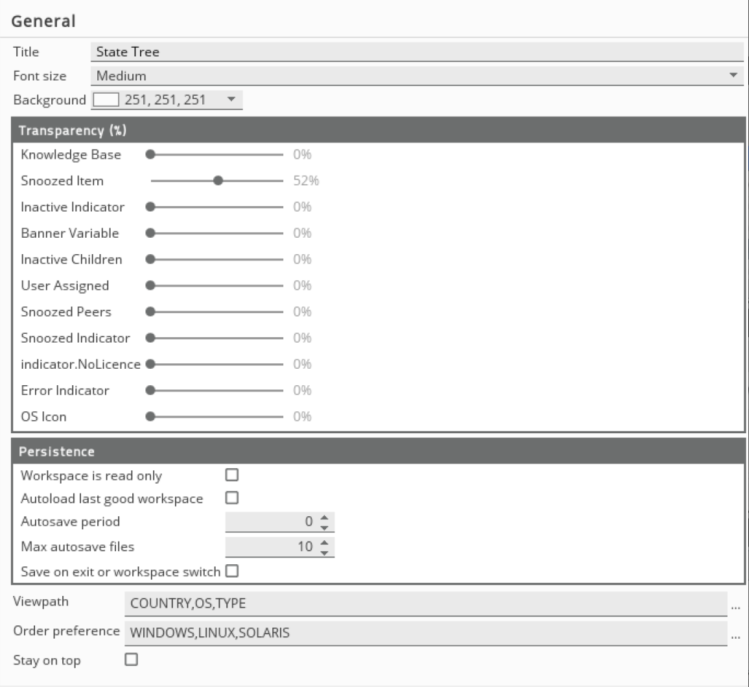If you are currently using version 5.x.x, we advise you to upgrade to the latest version before the EOL date. You can find the latest documentation here.
State Tree Dockable
Overview
The State Tree dockable displays the contents of all the Gateways known to Active Console in a hierarchical view.
It can be displayed either in Logical mode or Physical mode:
- Logical mode — it is Managed entity-centric that refers to the items in your monitored environment. Only managed entities and their sub-components are available in this mode, which is also known as Viewpath.
- Physical mode — it is Gateway-centric that uses the Gateway names or attributes to display data in State Tree.
To switch to either logical or physical mode, click State Tree![]() in the Toolbar.
in the Toolbar.
The State Tree also displays the snooze status of data items and if a data item has an error. This includes not just whether the item itself is snoozed, but whether it has descendants or ancestors that are snoozed as well.
The icons and their meanings are:
| Snoozed item | Description |
|---|---|
| Snooze
|
Data item itself is snoozed. |
| Snooze Child
|
Data item is not snoozed, but has one or more descendants that are snoozed. |
| Snooze Parent
|
Data item is not snoozed, but has one or more ancestors that are snoozed. |
| Snooze Child/Parent
|
Data item is not snoozed, but has one or more descendants and ancestors that are snoozed. |
To learn more about the icons that you can see in the State Tree, see Icons and Format Strings.
Edit the viewpath and order of entities view
The Viewpath is used when the State Tree is in logical mode. It uses the managed entity attributes to sort the tree into logical groups:
- If no viewpath is defined, then the state tree contains a list of all the managed entities configured in the connected gateways.
- If a viewpath is defined, then the state tree groups together the managed entities that have the same attribute value.
To customise the State Tree view, go to Workspace settings > General > Viewpath. For reference, see General settings in Workspace Settings.
For example, this is the default order of managed entities in the State Tree:

When you modify the Viewpath settings following the Country,Environment,Purpose,Role,Monitoring,Platform,Version order, this changes the order of managed entities in the State Tree to:

For example, if you have four managed entities (ME):
- ME1, with attributes 'Country = England' and 'City = London'
- ME2, with attributes 'Country = France' and 'City = Paris'
- ME3, with attributes 'Country = England' 'City = London'
- ME4, with attributes 'City = Hong Kong' and 'OS = Windows'
- ME5, with attributes 'Country = England' and 'City = Manchester' and OS='Linux'
- ME6, with attributes 'Country = France'
And the viewpath setting is "Country, City, OS". Then, the state tree is organised in the following way:
- England
- London
- ME1
- ME3
- Manchester
- Linux
- ME5
- Linux
- London
- France
- ME6
- Paris
- ME2
- Hong Kong
- Windows
- ME4
- Windows
In the given example, the items are sorted by the attributes defined in the Viewpath in order:
- The system gets the Country attribute of all the managed entities and create entries for each unique Country before putting the relevant managed entities under each Country.
- It divides the set of managed entities under each unique Country by the second City attribute.
This process continues until all the view path attributes are applied.
Where a managed entity does not have a value for a given attribute (in the example above ME4 does not have a Country), it is classified under an instance of the attribute (for example, England). Instead, it is inserted at the same level in the State Tree as the unique values for the attribute.
The net result is that Gateways can have entirely independent viewpaths, and still be displayed successfully in logical view mode.
Note: The definition of the attributes in the view path setting is case sensitive. By default, all items in the State Tree are ordered alphabetically.
You can force specified items to occur at the top of the items at any given level in the state tree by specifying them in the Order preference field.
- Go to ActiveConsole Settings > General > Order preference field.
- Type the order preference.
- Click Apply, and then click OK.

Note: The definition of order preference is case sensitive; any item that occurs in the State Tree can be specified in this way. You can specify many items in the Order preference (separated by commas) with items at the beginning of list taking preference over items at the end of the list
Limit the State Tree content
To restrict the level of data items that appear in the State Tree:
- Go to Workspace settings > Advanced > General > State tree leaf type.
- Select the preferred option on the State tree leaf type menu.
- Click Apply, and then click OK.
These options are available on the State tree leaf type menu:
- DataView — navigate down to the dataview level.
- Sampler — navigate down to the sampler level, but not dataviews.
- ManagedEntity — the state tree stops at the managed entity level and does not display the samplers or dataviews.
Note: The primary reason for restricting the data items in the state tree is due to performance. Stopping at the Managed Entity level is more efficient than stopping at the Dataview level. Workspaces that connect to larger Gateways gets significant performance gains on startup if the state tree is restricted.